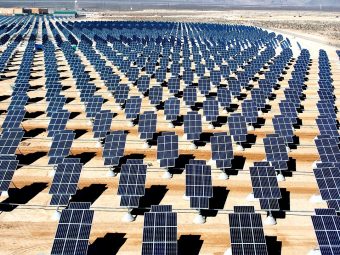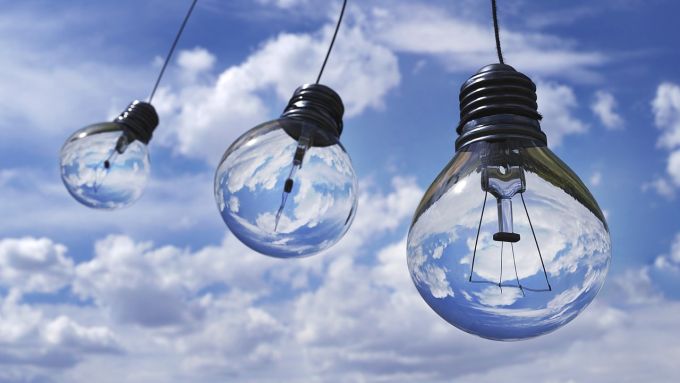 Alstom is partner of HackToscana, a hackathon organized by the Tuscany region to promote sustainable mobility in Italy. For the first time, a hackathon will be partly held on a train. More than 200 developers will embark in Florence on the Coradia Meridian regional train Jazz to reach Arezzo where they will continue to work, without interruption, until Sunday morning, 31 January. The format remains faithful to the traditional model of a hackathon, a 24-hour marathon in which participants from all over Italy will work to develop innovative business ideas in the field of sustainable mobility.
Alstom is partner of HackToscana, a hackathon organized by the Tuscany region to promote sustainable mobility in Italy. For the first time, a hackathon will be partly held on a train. More than 200 developers will embark in Florence on the Coradia Meridian regional train Jazz to reach Arezzo where they will continue to work, without interruption, until Sunday morning, 31 January. The format remains faithful to the traditional model of a hackathon, a 24-hour marathon in which participants from all over Italy will work to develop innovative business ideas in the field of sustainable mobility.
The aim of the event is to focus on the need for technological innovation in the transport sector, which has become essential due to the digital transformation now underway in all areas. The event will start on Saturday 30 January from Santa Maria Novella train station (Royal Hall, track 16) when all the participants will take the train to Campus LAB of Arezzo, Siena University space that will host the developers in the Library until Sunday 31 January.
Back in Florence, participants will meet in the Royal Hall of the Tuscany Region, where the projects will be presented, followed by the award ceremony. The prizes for the winning teams will be worth €5,000 for a total of €15,000. Alstom is constantly working on enhancing rail’s reputation as the greenest public transportation mode, striving to reduce the energy-related costs of its products, and is committed to reducing transport’s carbon footprint. In recent years, Alstom’s technical innovations have allowed significant reduction in the energy consumption of its trains.
“Jazz” is the latest generation of Alstom’s Coradia Meridian range designed for regional operators in Southern Europe, mainly in Italy. Designed to be eco-friendly, Coradia Meridian is 95% recyclable. It is an Electric Multiple Unit (EMU) train that can run at a maximum speed of 160 km/h, offering accessibility for all thanks to its low floor. Coradia Meridian regional trains are designed and manufactured by Alstom in Italy. Project development, most of the manufacturing as well as the certification are done in Savigliano site, in Cuneo. The Sesto San Giovanni plant (Milan) is responsible for the design and manufacturing of traction systems and auxiliary switchers. Train borne signaling systems are delivered by the Bologna site.
Source: www.alstom.com








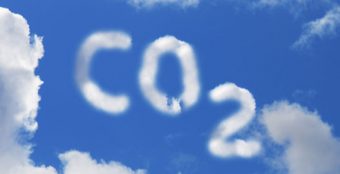



 Good environmental governance and sustainable development – central elements of the economic and environmental dimension of the OSCE’s comprehensive approach to security – are the focus of the two-day 1st Preparatory Meeting of the 24th OSCE Economic and Environmental Forum, which opened yesterday in Vienna. High-level officials, experts and key stakeholders from the OSCE’s 57 participating States and 11 Partners for Co-operation, and representatives of the business community, international organizations, civil society and academia are discussing how good environmental governance in the OSCE area helps to reinforce security and stability. In his opening remarks, the Chairperson of the Permanent Council, Ambassador Eberhard Pohl, representing Germany’s 2016 OSCE Chairmanship, stated that “the prerequisite to preserve and share natural resources in a globalized world is co-operation. The OSCE, with its broad approach to security, and its second dimension in particular, can contribute substantially to understanding and tackling this task.”
Good environmental governance and sustainable development – central elements of the economic and environmental dimension of the OSCE’s comprehensive approach to security – are the focus of the two-day 1st Preparatory Meeting of the 24th OSCE Economic and Environmental Forum, which opened yesterday in Vienna. High-level officials, experts and key stakeholders from the OSCE’s 57 participating States and 11 Partners for Co-operation, and representatives of the business community, international organizations, civil society and academia are discussing how good environmental governance in the OSCE area helps to reinforce security and stability. In his opening remarks, the Chairperson of the Permanent Council, Ambassador Eberhard Pohl, representing Germany’s 2016 OSCE Chairmanship, stated that “the prerequisite to preserve and share natural resources in a globalized world is co-operation. The OSCE, with its broad approach to security, and its second dimension in particular, can contribute substantially to understanding and tackling this task.”
 One of the few European capitals which can boast of having tap water which is perfectly drinkable without per-treatment. And Urbanscape Green Solutions are taking part in it. Through various projects, realized in the last few years and by greening the city roofs we added our piece to the decision of European Commission. With our Green Roof system on top of two main Info Points, where visitors get info about programme, events and activities taking place in Ljubljana and connected with European Green Capital 2016, we are proving our system (due to light-weight, efficiency of installation, high water absorption and much more) can be used practically everywhere.
One of the few European capitals which can boast of having tap water which is perfectly drinkable without per-treatment. And Urbanscape Green Solutions are taking part in it. Through various projects, realized in the last few years and by greening the city roofs we added our piece to the decision of European Commission. With our Green Roof system on top of two main Info Points, where visitors get info about programme, events and activities taking place in Ljubljana and connected with European Green Capital 2016, we are proving our system (due to light-weight, efficiency of installation, high water absorption and much more) can be used practically everywhere.
 2015 was Planet Earth’s warmest year since modern record-keeping began in 1880, according to a new analysis by NASA’s Goddard Institute for Space Studies.
2015 was Planet Earth’s warmest year since modern record-keeping began in 1880, according to a new analysis by NASA’s Goddard Institute for Space Studies.
 The energy storage market is shifting from R&D demonstration projects to a commercially viable market, states IHS, Inc. Q4 2015 saw a 45% increase in the global project pipeline, while 900 MW of projects are expected to be installed this year. The final quarter of 2015 saw a significant increase in planned global energy storage projects, up 45% on the previous quarter, to reach nearly 400 MW. The overall pipeline of planned battery and flywheel projects now stands at 1.6 GW.
The energy storage market is shifting from R&D demonstration projects to a commercially viable market, states IHS, Inc. Q4 2015 saw a 45% increase in the global project pipeline, while 900 MW of projects are expected to be installed this year. The final quarter of 2015 saw a significant increase in planned global energy storage projects, up 45% on the previous quarter, to reach nearly 400 MW. The overall pipeline of planned battery and flywheel projects now stands at 1.6 GW.


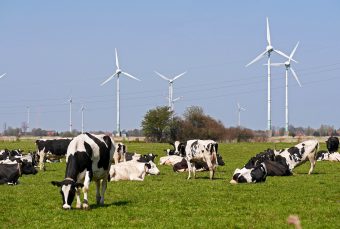

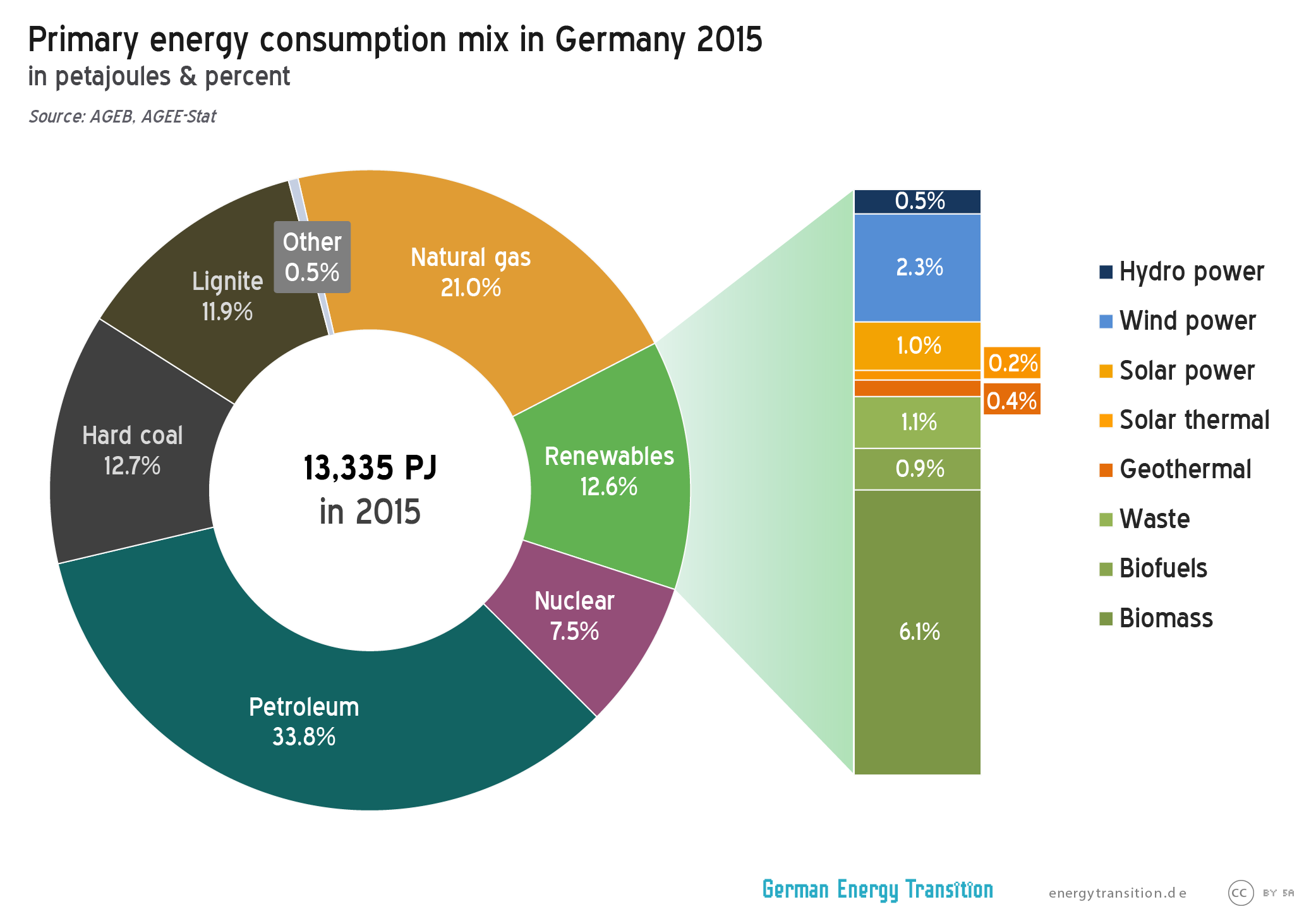
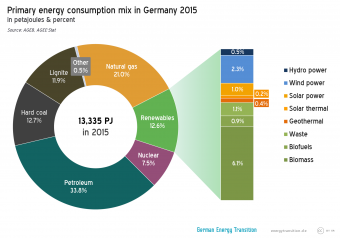 Germany has another five years to reach 18 percent renewable energy by 2020. From 2011-2015, the increase was a very modest 1.8 percentage points. Adding on that amount for the five remaining years up to 2020 only brings us to 14.4 percent, far short of the target. But there’s a problem with this calculation – it’s based on primary energy, whereas the EU targets for renewable energy are based on final energy. (Primary energy is a lump of coal or a tank of gas; final energy is the electricity from that coal or the motive energy from that gasoline.) When we adjust for this difference, we find a much different outcome. In terms of final energy, the share of renewables grew from 11.9 percent in 2011 to 15.3 percent in 2015, an increase of 3.4 percentage points over five years.
Germany has another five years to reach 18 percent renewable energy by 2020. From 2011-2015, the increase was a very modest 1.8 percentage points. Adding on that amount for the five remaining years up to 2020 only brings us to 14.4 percent, far short of the target. But there’s a problem with this calculation – it’s based on primary energy, whereas the EU targets for renewable energy are based on final energy. (Primary energy is a lump of coal or a tank of gas; final energy is the electricity from that coal or the motive energy from that gasoline.) When we adjust for this difference, we find a much different outcome. In terms of final energy, the share of renewables grew from 11.9 percent in 2011 to 15.3 percent in 2015, an increase of 3.4 percentage points over five years.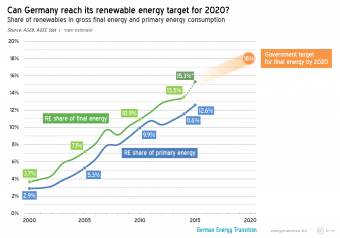 The progress in 2015 – an increase of possibly 1.8 percentage points – would be the largest in history if our calculation proves accurate. (To produce our estimate, we merely took the ratio of final to primary energy from 2012-2014, in which no nuclear plants were shut down – any such change would affect the ratio, which we found to be fairly close to 2:3 for those years). It is not completely unprecedented, however. In 2007, the share rose by 1.6 percentage points, mainly because bioenergy grew strongly that year; in addition to growth in the power and heat sectors, biofuels were at at 47 TWh that year (they have since fallen to around 35 TWh).
The progress in 2015 – an increase of possibly 1.8 percentage points – would be the largest in history if our calculation proves accurate. (To produce our estimate, we merely took the ratio of final to primary energy from 2012-2014, in which no nuclear plants were shut down – any such change would affect the ratio, which we found to be fairly close to 2:3 for those years). It is not completely unprecedented, however. In 2007, the share rose by 1.6 percentage points, mainly because bioenergy grew strongly that year; in addition to growth in the power and heat sectors, biofuels were at at 47 TWh that year (they have since fallen to around 35 TWh).
